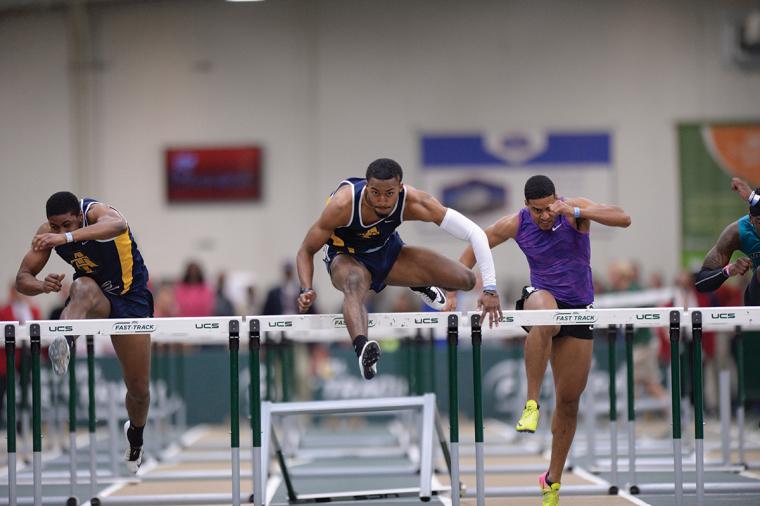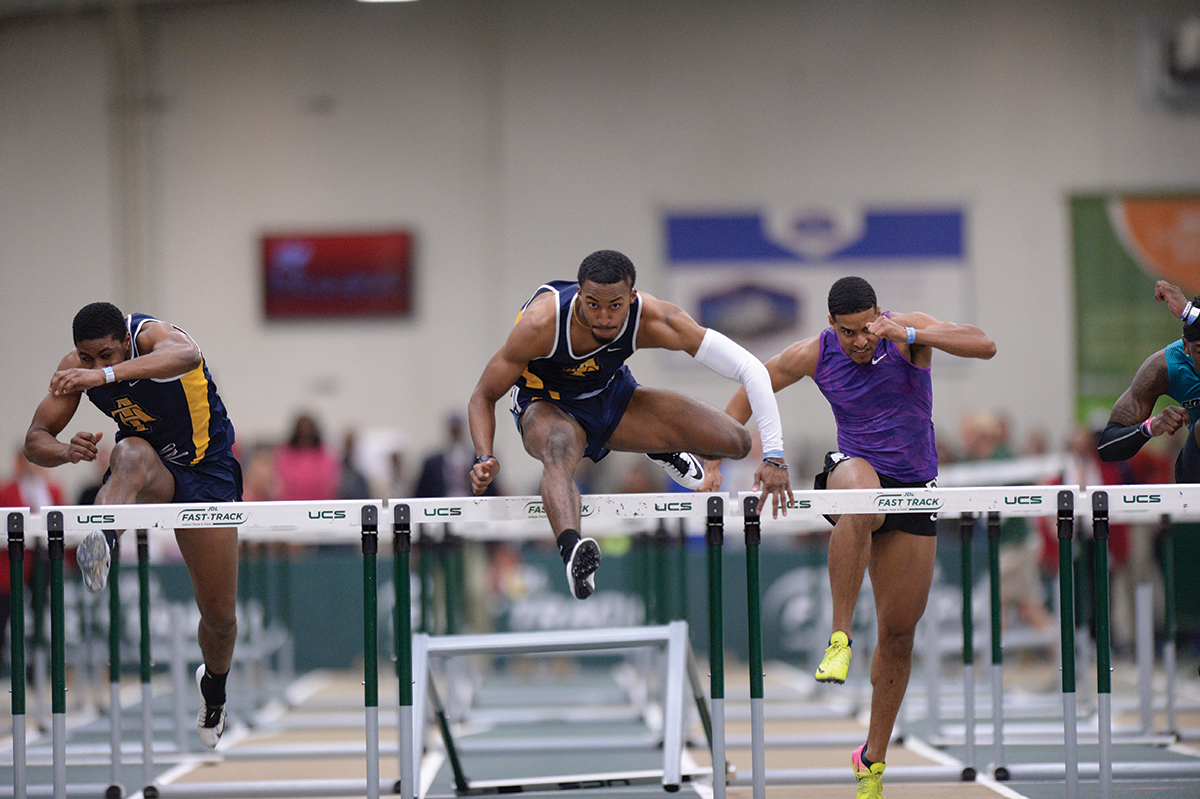

“Two massive events will be happening in this brand new stadium,” says Joey Jewell, senior director of the Eugene, Cascades & Coast Sports Commission, referring to the fabled facility’s recent renovation. “We’re really looking forward to them. Track is back.”
And what better way to showcase the sport’s return than at an iconic, century-old venue that has hosted the Olympic Trials in 1972, 1976, 1980, 2008, 2012 and 2016. Hayward Field now boasts a new nine-lane track with 12,650 permanent seats (and expandable to almost 25,000). The design objective was to create a “theater” for track and field with unobstructed sight lines, stellar acoustics and spacious seating — with the first row at track level.
Rising above the stadium is 10-story Bowerman Tower, a symbol of the Olympic torch that pays homage to Bill Bowerman, Oregon’s longtime track coach and Team USA’s head coach at the 1972 Olympics.
With a reported price tag of $270 million, the two-year renovation project was funded by Nike’s Phil and Penny Knight and other donors, and it was ready to go in Spring 2020. Then came the coronavirus pandemic. One year later, University of Oregon and TrackTown USA officials, along with local hotel and other business owners, and sports tourism leaders have high hopes for the new and improved Hayward Field.
“We have this amazing facility, and we all know that sports tourism tends to lead economic recovery in communities,” Jewell says. “We’ve raised the bar in the track community, and we’re getting the biggest event in the world for track and field with the Olympic trials. That’s huge, both economically and from a tourism standpoint.”
The NCAA Championships are scheduled for June 9-12, with the Olympic Trials slated to begin six days later and run from June 18-27. Hayward Field also will host the World Athletics Championships in 2022 — the first U.S. city to host the biennial global event.
The economic impact of the Olympic Trials alone is about $38 million, Jewell says. While that figure likely will be significantly lower this year — considering that as of late March, it remained unclear whether fans would be allowed into Hayward Field — Jewell is not complaining. “We’re aware some of the logistical pieces will have to change on a dime,” he says. “But just having these events back in Eugene is uplifting for our community.”
‘Do Everything Safely’
While most destinations, including Eugene, were unable to host track and field meets throughout most of 2020, Florida’s Space Coast welcomed what might have been last year’s largest track and field event. After the Hampton Roads Sports Commission in Norfolk, Virginia announced that coronavirus-related restrictions prevented the city from hosting the 54th Amateur Athletic Union Junior Olympic Games — scheduled for late July and early August 2020 — Brevard County stepped in and offered several venues, including the eight-lane track facility at Satellite Beach High School, which underwent major renovations in 2018.
Florida’s restrictions were not as stringent as those in many other states last summer, but pulling off the Games was still a challenge for local leaders who had less than two months to not only prep and but also ensure the safety of participants, coaches, officials and spectators.
“We started with the county health department and asked how we could keep everybody safe,” says Rusty Buchanan, president and chief executive officer of AAU USA, which is headquartered in nearby Lake Buena Vista, Florida. “We knew that it may not look like a traditional Junior Olympics, but we wanted to see what we could do.”
Working in collaboration with Space Coast Office of Tourism, Governor Ron DeSantis’s Office, the Florida Sports Foundation, the School Board of Brevard County, the Brevard County Board of County Commissioners and the Sunshine State Games, AAU developed a series of safety protocols that included temperature checks, mandatory face masks (in accordance with a local ordinance), bleacher pods for athletes, limited entrances and exits, and a maximum of 50 people on the track at any given time. Event officials were placed in a housing bubble throughout the course of the games, and they wore face masks and face shields. Law enforcement officials and emergency medical personnel were onsite at all times to ensure compliance.
Additionally, the pole vault and the high jump events were removed from the schedule because officials could not come with up with a feasible mat sanitization strategy.
“People were just happy to compete, and compliance to wear a mask was not a big deal,” Buchanan says. “We weren’t the ones who opened the state for sports, but we wanted to make sure we could do everything safely.”
In the end, about 4,100 athletes plus their families — including about 2,800 track and field participants — from about 40 states showed up to compete in a dozen sports, giving the Space Coast an estimated economic impact boost of $3.5 million. Buchanan says he didn’t hear about a single reported case of coronavirus among attendees.
Meanwhile, Holy Trinity Episcopal Academy — a private college-prep school in Melbourne — opened a new eight-lane track last year and hosted the 2020 Florida Senior Games’ track and field events in December.
Midwestern Pace
At least one other high-profile track and field meet took place last summer: The Blue Oval Showcase at Drake University’s historic Drake Stadium in Des Moines, Iowa. About 80 of the sport’s most elite athletes in the world, including Olympic gold medalists, competed in 11 events in late August 2020 with no spectators in attendance.
“To our knowledge, it was the only track and field event held in the United States for elite athletes last year,” says Greg Edwards, president and chief executive officer of Catch Des Moines. “Those elite athletes wanted to compete and stay active.”
The all-brick Drake Stadium opened in 1925. It holds almost 15,000 fans and is home to the famous Drake Relays — considered one of the top track and field events in the United States. The stadium also has hosted the USA Track & Field Outdoor Championships and the annual Iowa High School Co-Ed Track and Field State Meet, plus it will welcome the AAU Junior Olympic Games in 2023.
“There’s a lot of competition in the track and field market these days, but Drake Stadium is still at the top of the list,” Edwards says. “It’s the flagship for the sport.”
Meanwhile, one state to the west, Lincoln, Nebraska, is home to multiple track facilities, including ones at Nebraska Wesleyan University and Lincoln High School’s Beechner Athletic Complex. But the primary venue is the University of Nebraska’s Bob Devaney Center, which houses one of only nine indoor hydraulic-banked tracks in the United States. The six-lane, 200-meter track is supported by both wood and steel frames and has the largest radius (67 feet) of any indoor track in the world. The facility recently upgraded its bleachers and can now accommodate almost 5,000 spectators, plus a new lighting system makes it more camera-ready for televised events, according to Derek Bombeck, sales development manager at the Lincoln Convention and Visitors Bureau.
Nebraska also is constructing a new outdoor track stadium near the Devaney Center as part of the university’s “Go Big” athletic facilities expansion project.
“The Bob Devaney Sports Center’s track and field facility has had a tremendous impact on tourism in Lincoln,” Bombeck says. “Not only does it host many Division I competitions each year, but it has also played host to many postseason events such as the Big 12 and Big 10 Men’s and Women’s Track and Field Championships, as well as the NCAA Division III Track and Field Championships.”
He adds that Lincoln expects to bid on many USATF events “in the near future.”
College Facilities in the Southwest
Plenty of other cities also offer venues capable of hosting high-profile meets. Take Lubbock, Texas, home to several track and field facilities — including Texas Tech University’s Sports Performance Center, which boasts an indoor 200-meter banked track and seating for up to 2,000 spectators, and the outdoor Terry and Linda Fuller Track & Field Complex, which can seat up to 5,000.
“It has one of the fastest track surfaces in the world,” Scott Harrison, director of Lubbock Sports, says about the outdoor complex’s eight-lane Mondo Super X surface, adding that the Sports Performance Center hosted the Big 12 Indoor Track and Field Championships in February (with no spectators). “As home to the reigning NCAA men’s outdoor track and field national champions, Texas Tech offers a competitive atmosphere like no other.”
Lubbock Christian University’s Soccer and Track Complex, meanwhile, was completed in 2020 and features an eight-lane track, and area school districts also operate three large track and field facilities.
Almost 10 hours due east of Lubbock is Conway, Arkansas where two more colleges and universities — the University of Central Arkansas and Hendrix College — offer outdoor track and field opportunities.
Events at both UCA’s Bill Stephens Track/Soccer Complex and Hendrix’s Young-Wise Memorial Stadium were canceled in 2020 due to the pandemic, but Rachel Shaw, executive director of the Conway Convention and Visitors Bureau, is optimistic about this year.
“It is my hope that with our track and field facilities being outside, we are able to see a bounce back in this sector of sports tourism quickly,” she says. “We obviously missed hosting those events in 2020, but with guidelines in place, I think they can come back successfully in 2021.”
Not all high-profile track and field facilities are affiliated with colleges and universities. In fact, the pandemic and other factors have forced the elimination of the sport on some campuses.
“Some colleges and universities have had to drop their indoor track and field programs due to budget cuts, so active programs may need to travel more for strong competitions,” says Bonny Bernat, senior sports and events sales manager for Visit Winston-Salem, noting that the privately operated JDL Fast Track indoor facility — anchored by a 200-meter oval — hosts such major events as the NCAA Division III Men’s and Women’s Indoor Track and Field Championships. “Through the years, the facility has upgraded technology for livestreaming meets, increased food and beverage operations for spectators, and added a second throws ring.”
In Alabama, the city-owned Birmingham CrossPlex is gearing up to host the World Games 2022, which is expected to bring about 3,600 athletes from more than 100 countries. While the program does not include track and field events, the Games are an indication of the facility’s flexibility.
The CrossPlex boasts a 4,000-seat indoor track and field venue with a hydraulically banked track, and it has hosted everything from local youth and high school meets to NCAA Division I, II and III national championships, (The sprawling facility also includes an arena and natatorium.)
“The Birmingham CrossPlex has created a lot of economic impact for our community,” says David Galbaugh, vice president of sports sales and marketing for the Greater Birmingham Convention & Visitors Bureau. “Before it opened in 2011, we really didn’t have a foothold in the track and field space. The CrossPlex put us on the national radar.” SDM

